Kasra Aarabi
Engelsberg Ideas, June 18, 2025
“While the IRGC has spent time, resources and blood over the decades in its costly pursuit of the nuclear weaponisation threshold, this pillar has always remained more aspirational than assured.”
As Israel’s targeted strikes inside Iran continue, the longer-term implications for the Iranian regime’s military doctrine and leadership are beginning to surface. A sober analysis reveals that the consequences leave Tehran with little room to manoeuvre.
For decades the Islamic Republic has built its military doctrine on three key pillars. First, a network of Islamist militias across the Middle East, either created or co-opted by the Islamic Revolutionary Guard Corps (IRGC) – the regime’s ideological army. The IRGC has worked for decades to exploit vacuums in neighbouring countries to radicalise, recruit and mobilise foreign nationals into organised armed proxy groups loyal to the supreme leader, Ayatollah Ali Khamenei. Given the Shia Islamist nature of Iran’s theocracy, the IRGC primarily targeted Shia communities across the region, manufacturing ideologically compliant militias from radicalised constituencies. The creation of Hezbollah in Lebanon in 1982 became the gold standard for this approach – what would become known as the ‘Hezbollah-ization’ of the region.
Crucially, the regime did not let sectarianism limit its ambitions. It leveraged the antisemitic and anti-Western tenets of its ideology to co-opt and collaborate with Sunni Islamist groups, including Hamas, the Taliban, and Al-Qaeda. Backed by billions of dollars for arms and military training, this strategy enabled the regime to build an extensive and lethal network of Islamist militias.
A comprehensive ballistic missile and drone programme served as the military doctrine’s second pillar. The Iran-Iraq War ignited the development of a self-sufficient ballistic missile programme. But with little expertise in missile technology, senior members of the IRGC turned to rogue foreign regimes for assistance. What was initially supported by dictators from North Korea, Libya, and Syria, became a booming domestic missile programme. …SOURCE


